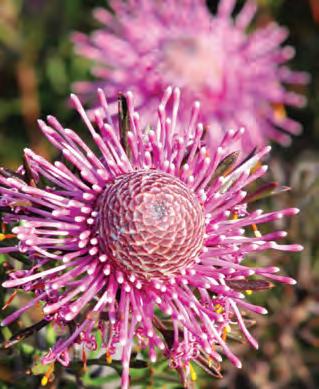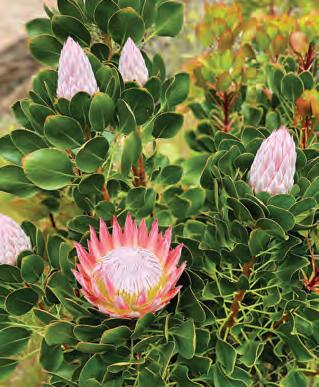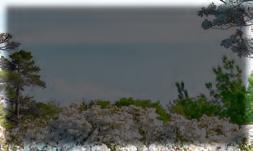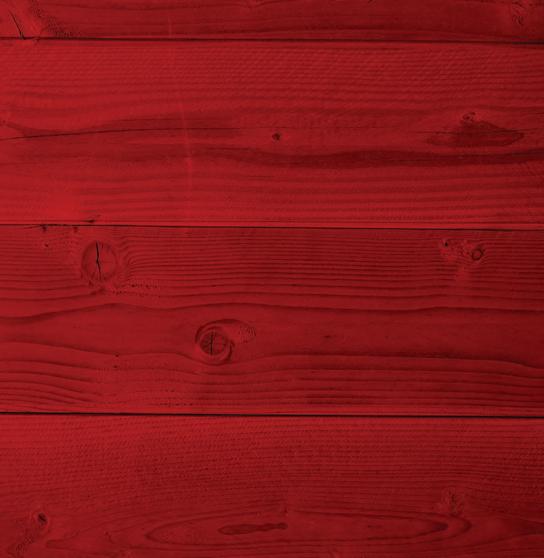
13 minute read
Proteas, The Unconventional Beauties

Proteas
Advertisement


The Unconventional Beauties Whose Time Has Come
The hills around Fallbrook are home to some of the world’s most increasingly in-demand cut flowers
by Sandra Shrader
Proteas are all about flower power and staying power.
From a lineage of some of the oldest of plants on earth dating back to a time before dinosaurs became fully evolved, proteas, with their prehistorically edgy and unconventional appearances, are flourishing in the cut flower industry today.
Demand for them by the floral trade has risen in the past 20 years from near obscurity to being must-haves in bouquets and arrangements for weddings, special occasions, holiday


OUR MISSION IS
Visit us online to learn more about our club and to see some of our exciting upcoming events!



Fallbrook Garden Club was established in 1931.
A Charter member of California Garden Clubs, Inc., a member of Pacifi c Region Garden Clubs, Inc., and National Garden Clubs, Inc. For more information visit our website
decorations and personal gifts of appreciation and love.
Varieties of the popular Proteaceae family, however, are presently only best grown in a number of select places in the world, and the hill country around Fallbrook and Rainbow is one of those areas.
The right combination of Mediterranean climate conditions here: full sun, mild winters, good air circulation, and sandy, somewhat acidic, well-draining soil are all components which encourage proteas to produce their intriguing flowers.
According to Diana Roy, flower farmer, business manager and creative director of Resendiz Brothers Protea Growers, located in Rainbow, protea flowers are truly unique in the floral kingdom.
“I have been involved with the growing of Proteaceae plants for more than two decades, and I still love them. They are incomparable, and there are just so many amazing varieties that they are never boring,” Roy said.
“Proteas produce flowers and foliage which are each very different and have exotic shapes, and they are colorful—they come in rich jewel tones of nearly every color of the rainbow. Added to that, they can last for up to three weeks as cut flowers. That makes proteas great floral choices for almost every occasion,” she said.
The Proteaceae family of plants encompasses some 73 genera and more than 1,500 species including the more recognized genus King protea, protea aristata and protea compacta, all of which have enormous flower heads reminiscent of either crowns or artichokes and tall sturdy stems.
The flowers from these protea generally range in lipstick colors from deep crimson to fuchsia to hot pinks and have names like “Pink Ice,” “Pink Mink,” “Rose Mink” and “Blushing Bride” as well as white and cream species fancifully labeled as “White King” and “Sugarbush.”
Other popular members of Proteaceae grown this region are Leucospermum which are commonly called “Pincushions” because they resemble the pincushion tool used by a seamstress to hold sewing pins. The main colors of the spidery-blossomed Leucospermum are vibrant yellows, golds, oranges and reds and have names like “Tango” and “Scarlet Ribbon.”
These flamboyant kin of Proteaceae have their fans too.




Ismael Resendiz photo
Stephanie Baxter selects protea flowers in spring. Leucospermum or ‘pincushions’ Shane Gibson photo are harvested. Diana Roy photo

“Right now, the pincushions are blooming on our property,” Stephanie Baxter said. She and her husband Dave Baxter own five acres in De Luz which are filled with proteas.
The couple is active in the local protea community and has hosted Resendiz workshops about germination, care and management needed for growing the plants.
“Leucospermum starts blooming in January, but by March and April the plants are full of flowers. Until the bloom time tapers off by the end of spring, every day looks like a field of mini-fireworks, all bursting in yellow, gold, and orange. The colors are absolutely out-of-this-world glorious,” Baxter said.
Not to be left out of the Proteaceae party in the hills are the Leucadendron species, sometimes referred to as conebush, which has colorful foliage and stems with large stamens that look like small pinecones. Although not as exuberant in color as other proteas, these sturdy-stemmed plants add drama as filler to floral arrangements.
Banksia is another exotic species of the protea family grown locally. It has spectacular cylindrically-shaped flower heads as well as leaves which have serrated edges, and each species looks very different from the other.
Resendiz Brothers Protea Growers, which began operating at its present location in 1999, is considered to be one of California’s largest suppliers of proteas, and ships more than 300 varieties of the proteas, pincushions, leucadendrons and banksia, in addition to filler flowers and wax flowers, throughout the United States and Canada. The business is located on approximately 200 steep hilly acres in Rainbow, and it additionally manages properties where proteas are grown in this area by independent owners.
The ancient Proteaceae clan, however, is not native to North County San Diego, let alone native to North America.
Scientists have traced the origins of Proteaceae back 300 million years to the time of the supercontinent Gondwanaland which was located in the Southern Hemisphere. The movement of the earth’s tectonic plates in the Early Jurassic Period 180 million years ago slowly and relentlessly began causing the breakup
Bishop’s
Tree Service

TREE CARE EXPERT TEAM
FULLY INSURED | LIC. #770246
WE MAINTAIN THE BEAUTY AND SAFETY OF TREES!
Bishop’s Tree Service, Inc. is a family owned business with 3 certifi ed arborists and a tree safety professional on staff . Owner, Brian Bishop, has been serving North County’s Tree care needs for over 40 years. Trees defi ne your property, give them a little love and if need be we can help.
TREE CARE
• Crown Cleaning • Crown Reduction • Crown Restoration • Raising the Canopy • Thinning • Clearing the Underbrush • Structural Pruning
TREE REMOVAL
• Removal of all sizes and quantities of trees • Stump Grinding • Brush Clearance/Chipping • Line Clearance
RESIDENTIAL & COMMERCIAL Serving North County
Please call us today for your free estimate, mention this ad for a discount. 760.720.9649
www.BishopsTreeService.net

Protea: The flower that can change its form, with origins dating back 300 million years. Ismael Resendiz photo Stephanie Baxter selects protea flowers in spring.

Shane Gibson photo
of Gondwanaland to form Africa, Madagascar, South America, Australia, New Zealand, New Guinea, etc.
Throughout the eons of continental drift, dinosaur dynasties and meteor crashes, however, proteas survived. The vast majority of them naturally hybridized in South Africa, Australia and New Zealand where they are still found in the wild and on farms today.
The plants first attracted the attention of botanists visiting the Cape of Good Hope in South Africa during the 1700s, and many




DISTINCTIVE BARNS & BUILDINGS
Select from many colors!
Steel Buildings • Shade Covers • Metal Roofing • Solar Structures •
760-690-2891
of the strangely dramatic species were introduced to Europe in the 18th century.
In 1735, Carl Linnaeus, the famous Swedish botanist is believed to have named the plants “Protea” after the Greek sea god Proteus, the son of Poseidon. As the legend goes: Proteus was a sea god who had the power to know all things past, present and future, but he was defiant, maybe rebellious, and preferred to nap on the island of Pharos rather than do prophecies. To deter those seeking his insights, he would change his shape at will.
Thus it was commonly accepted that the protea family was named after Proteus because its flowers and foliage came in an astounding variety of shapes, sizes, hues and textures.
The first known successful cultivation of proteas by humans happened in the late 1700s when the Englishman Joseph Knight tried to grow them under artificial conditions. He eventually succeeded, and the first species to be produced domestically was displayed at London’s Royal Botanical Gardens at Kew in 1774.
But the plants received little interest by the established flower trade industry during the next two centuries. It wasn’t until the 1960s that proteas were first introduced in California, and even then it took the King of Camellias to do it.
Acclaimed in the 1950s for his expertise in camellias, Howard Asper was responsible for the planting of camellias from Japan, Hong Kong and the islands of the Pacific in the famed Descanso Gardens and the Huntington Botanical Gardens. He also created several hybrids of camellias and became influential in trade associations for cut flowers.
Asper retired from the Huntington in 1962 to devote his time to growing more camellias, but he also became fascinated by the unusual-looking proteas and began experimenting for the first time with growing them at his Green Valley Ranch in Escondido.
As it happened, a camellia flower blight took place around that time, and during the interim Asper was forced to quit selling camellias as cut flowers. Protea cut flowers became his primary crop, and he became the first nurseryman in the U. S. to grow proteas commercially, all while remaining a horticultural ambassador for camellias.
In 1977, Asper again “retired” and sold his nursery to his son, but he did not enjoy retirement. At the age of 75, he began
– Diana Roy


Serruria – this delightful genus of 44 species from South Africa’s Cape is a another popular member of the Protea family.
growing protea once more in 1978 at his Zorro Protea Farms just south of Rancho Santa Fe in North San Diego County.
For his work growing proteas and initiating the protea cut flower industry, Asper acquired the second of his botanical crowns and was dubbed the “Protea King.”
Just how proteas began to be grown in quantity in the greater Fallbrook region is largely due to local protea farmer Ismael “Mel” Resendiz, the founder and present-day owner of Resendiz Brothers Protea Growers.
At the age of 18, Resendiz found a job as a farmhand in 1978 working at Zorro Protea Farms, then owned by Asper and Dr. Peter Sacks. It was Resendiz’s first introduction to the Proteaceae family. He had never seen such otherworldlylooking flowers before, but he too soon fell under their spell.
Along with his brothers, Resendiz worked at the Zorro farm for 20 years, acquiring more and more knowledge about the needs and optimal conditions to propagate, grow and harvest proteas. During that time, he purchased 10 acres in Rainbow because, as he said in a 2013 interview, “there is beautiful soil here, full of decomposed granite”, the right level of acidity levels, coastal breezes and steep hills with a 75% grade.


Protea Ceres – A queen size bloom or what we call a ‘Hybrid Queen.’ When fully open, this stunning protea is often 5 to 6 inches in diameter. Diana Roy photos








Harvesting and delivering happiness, is how we find joy today and everyday. Diana Roy photo A guest at Resendiz Brothers Protea Growers picks flowers for an arrangement. [Background] A variety of protea species called Sugarbushes. Shane Gibson photos Beautiful blooms ease stress, lift spirits and provide a connection to nature. Diana Roy photo


In 1998, Zorro Protea Farms was closed and the land sold to make way for a golf course and housing developments. A year later, Resendiz decided, after persuading his brothers to join him, to continue with protea production at his Rainbow property.
He also reached out to Roy, a former hotel and convention event planner who had become passionate about proteas and planted them on her Temecula (De Luz) property, about joining forces with his new company. In December 2001, they shook hands and agreed—Resendiz would oversee the fields while Roy ran the office.
Resendiz began acquiring more property and planting the hillsides with proteas, pincushions, leucadendrons and other native Australian and South African Proteaceae species. It can take three to five years before a return on investment occurs and an abundance of flowers can be harvested for wholesale, according to Roy.
In addition to acquiring new hybrids of proteas when available, Resendiz established a growing system in which he was able to harvest year-round by planting an array of species that bloom at different times of the year.
Then and now, Roy handles the business end, but she also continues to oversee a multifaceted promotional campaign including trade shows, leadership in horticultural and cut flower associations, and print and social media venues.
Resendiz Brothers Protea Growers’ pro-protea campaign when it started two decades ago was by many accounts the first of its kind, and was largely instrumental in pushing the formerly unknown plants in the national cut flower limelight.
As with nearly all of the protea growers and harvesters in the North County region, Resendiz Brothers Protea Growers is a wholesaler, mostly concentrating on the sale and shipping of cut flower proteas and other filler foliage. The internationally recognized grower and other smaller-volume farms like Booth Farms Protea in Valley Center, however, do provide some opportunity for people who yearn to have a few irresistible exotic protea plants in their own yards.
At events like the annual Fallbrook Avocado Festival and the Del Mar Spring Garden Show, the growers’ protea plants in pots are available to the public as part of the California Protea Association’s education program.
“Proteas do well in pots. People just need to remember that sandy, well-draining soil is what the plants require—avoid using any fertilizers at all because they will kill the proteas,” Baxter said. “And keep the plants in places where the sun can warm their roots which are near the top of the soil. The proteas will probably thrive then,” she said. Indeed, the plants with prehistoric pizzazz are having their day in the sun now. “It’s taken 20 years to educate the floral industry and the public about proteas,” Roy said, adding that the flowers are not only standouts in their own bouquets, but that proteas have gotten so popular now that it’s no longer unusual to see them mixed with roses, lilies, tulips and other more mainstay flowers. “But we are so pleased to see these unusual and dramatic flowers and plants finally getting the attention and admiration they deserve.”











